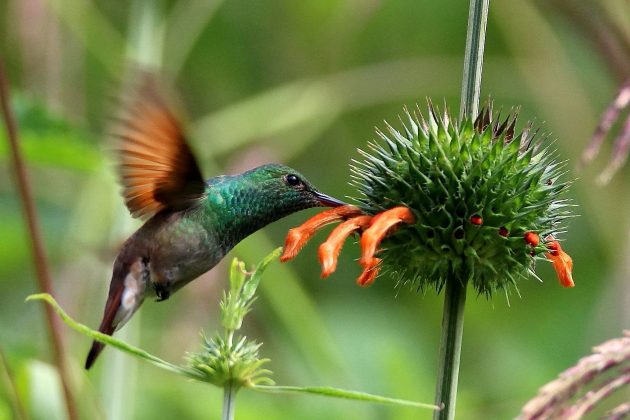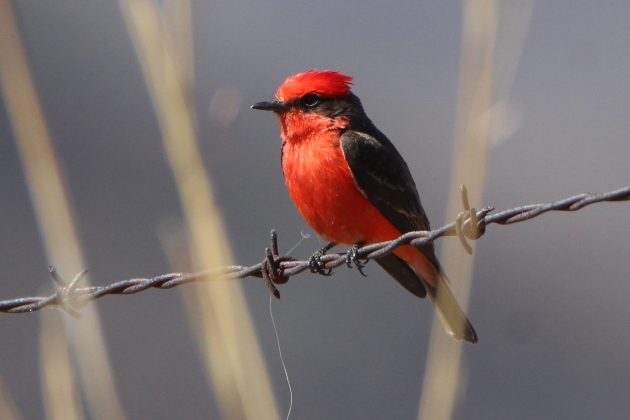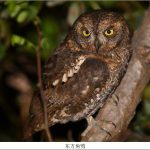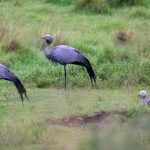
So I haven’t had much birding excitement to write about in the past couple of weeks. But I have been able to enjoy going through photos from previous years (2022, right now), permanently saving the best and eliminating all the others. Doing so made me think of finding a subject that would focus on some such photos.
Readers who studied some Spanish in school are likely to remember that the word for “bird” in that language is pájaro. However, while even most native Spanish speakers don’t know it, that is not entirely true. The word pájaro only applies correctly to perching birds, of the Passerine family. Waterfowl, shorebirds, birds of prey, and other non-Passerine birds are covered by the word aves. And this post is about central Mexico’s aves navideñas, or, my list of Mexican Christmas birds.
My part of Mexico’s highlands has no naturally-occuring parrots, which would be our natural starting point for red-and-green birds. Fortunately, we have no lack of other brightly colored aves. Certainly we can start with our hummingbirds, of which we have fifteen in the area above 2,000 meters (6,600 feet). (I’ve seen six more species in lower parts of Michoacán.) A good Christmas hummingbird for starting would be our Broad-tailed Hummingbird, with its green body and rose-red gorget.

Unfortunately, this photo of an immature Broad-tailed Hummingbird is the only one I have achieved with even a hint of its rose-red throat.

Still, there is no green like the green on the head of the Berylline Hummingbird. And these hummers are exceedingly common in central Mexico — in fact, they are exceedingly common in my own backyard.



If you squint just right, you can even see a hint of red in the Berylline’s lower parts.

Another bird ensures that you can see the color red everywhere in our region. This is the ubiquitous Vermilion Flycatcher. As long as it is an adult male, its red breast never fails to excite, in spite of its being so common here.


I could also point out the bright red of our winter-only Summer Tanager. (Yes, I know I just wrote an oxymoron.) But these often lose their red color in the depth of winter, which they spend here. Fortunately, Hepatic Tanagers are residents, and their male colors never vary. Their name may say they are liver-colored, they look plain red to me.


Still, the slightly orangey reds of these two birds cannot spell Christmas like the red and white of our endemic Red Warbler. The fact that this warbler is always found in conifer forests make it even more Christmassy.


And yet, there is an even better way to say Christmas than red with a bit of white. That would be red with lots of green. The delightful Red-headed Tanager gets the right combination of colors, but doesn’t quite get the tones right:


Two birds, however, get all the Christmas colors just right. While some Mexican trogons have yellow breasts, the only two trogons of the Michoacán highlands offer the perfect shades of red, green, and white. They are the perfect aves navideñas.

Mountain Trogon

Elegant Trogon
For good measure, I’ll end with a pair of seasonally festive bromeliads. ¡Y a todos, una feliz navidad!













A nice question for theologians or paleo-ornithologists: what WERE the real Christmas birds back in the year zero, in or around that stable? I asked an artificial intelligence thingy, turns out they were Rock Dove, House Sparrow, Common Raven, Eurasian Hoopoe, Barn Owl,
Common Swift, Little Owl, Eurasian Jay, Blackbird and Chukar Partridge. Barn Owl was my guess…
Contributors/readers with experience in Middle Eastern birds could probably tell us which ones are most likely to feed on livestock poop there, since there was probably a lot of it around. A Christmas Cattle Egret, perhaps?
But were they there in 0 AD?
Oh no. I had no idea pajaros correctly referrs to passerines, and aves to the others.
Wait a minute. In Los Tres Caballeros, Donald Duck is watching a movie called ‘Aves Raras.’ In it, we see a tijereta (fork-tailed flycatcher) cut off the hairdo of a pompador (I think) cotinga. Flycatchers are passerines (and cotingas, also, I think). Shouldn’t Walt or his touring artists know the difference?
Frank, the rule is that all pájaros are aves, but not all aves are pájaros. In other words, all passerines are birds, but not all birds are passerines. So Tijeretas are both aves AND pájaros. Donald, however, would only be an ave.
Having said that, I should point out again that my only Mexican friends who make this distinction are ornithologists and/or birders. Pretty much every one else just says “pájaros”, although often incorrectly.
And Peter, apparently you were right, Cattle Egrets were not in Israel in 0 AD. I learn something new every day.